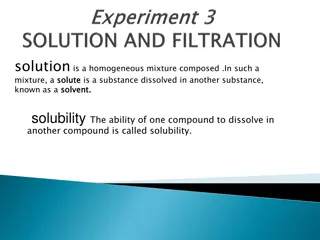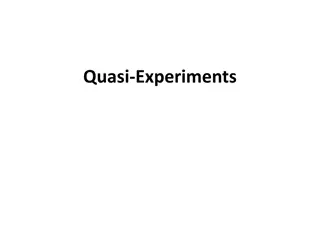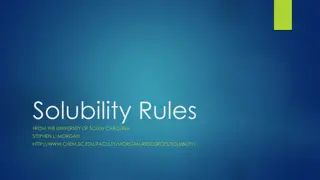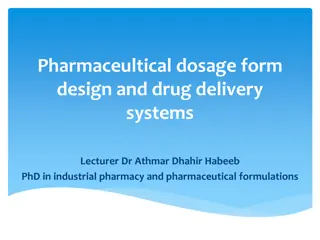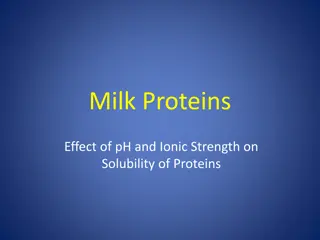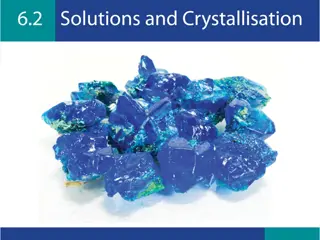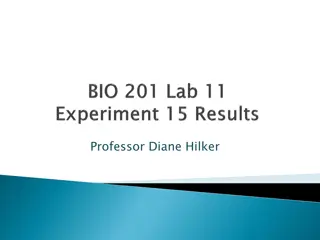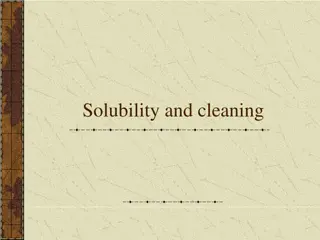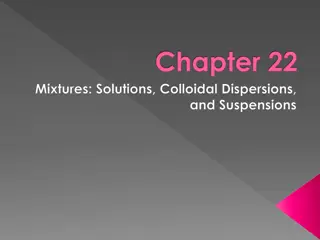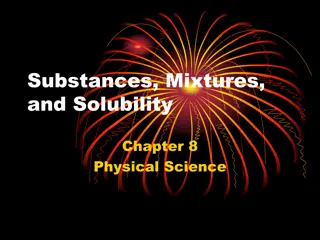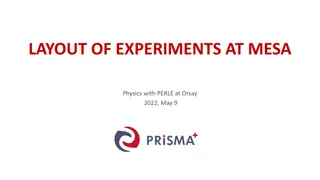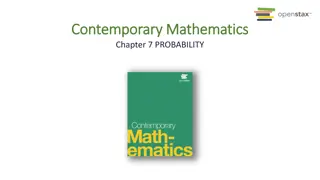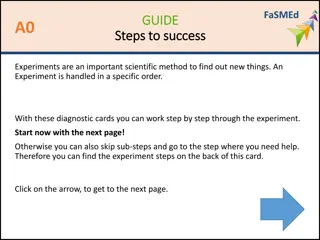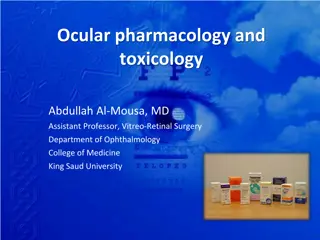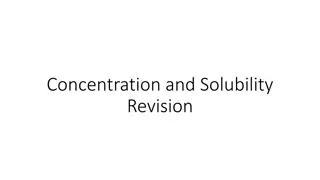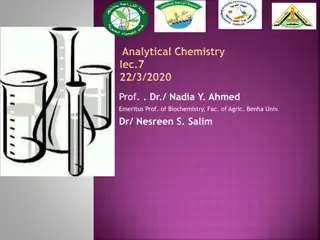Understanding Solubility: Applications and Experiments
Solubility plays a crucial role in various applications such as cleaning, separation, and identification. This content explores how solubility works with practical examples using magnets and marbles to illustrate the concept. Discover the differences between polar and non-polar compounds through hands-on activities and visual aids.
Download Presentation

Please find below an Image/Link to download the presentation.
The content on the website is provided AS IS for your information and personal use only. It may not be sold, licensed, or shared on other websites without obtaining consent from the author. Download presentation by click this link. If you encounter any issues during the download, it is possible that the publisher has removed the file from their server.
E N D
Presentation Transcript
Solubility Applications for Solubility Cleaning Separation (purifying) Detection & Identification
If you need to remove some grease and dont have any soap around, you can use items that are greasy to dissolve the grease. For example, cooking oil or butter would work. Milk has fat in it, so it could work. Even potato chips would work because they are cooked in oil.
Lesson on how solubility works. Magnets can be called polar because they have north and south poles. Glass marbles would be non-polar because all their sides are the same.
Lesson on how solubility works. Throw a bunch of bar magnets in with glass marbles and shake.
The magnets start finding other magnets because the north pole of one magnet attracts the south pole of a different magnet. Keep shaking.
You will discover that the magnets will separate themselves from the marbles because magnets have no attraction to marbles. This is similar to how water (a polar compound) will separate from oil (a non-polar compound) N S N S
Start over with a mixture of bar magnets, horse-shoe magnets, wood balls, wood sticks, and glass marbles. Shake. S N
Magnets have north poles that attract south poles (polar). This causes them to group together and separate themselves from items they have no attraction for such as the wood and glass items. (non-polar items). This is similar to what would happen when water and salt (two polar compounds) are mixed with gasoline, wax, and lighter-fluid (all non-polar compounds). The non-polar compounds stay mixed up, but the water and salt will end up together away from the other compounds. S N S N N S S N
Water: A polar compound Water is polar, but instead of magnetic poles, it has plus and minus (negative) poles (ends). N S H H O N S
Water: + and - sides. Notice the top half of water has more protons. This combined with the fact that oxygen pulls hydrogen s electrons closer to the oxygen atom makes the top side of water more positive than the bottom side.
Water: the Universal Solvent The + side of water will be attracted to any negatively charged ion. The side of water will be attracted to any positively charge ion. This allows water to pull apart ionic compounds such as NaCl (table salt) or many other salts (metal bonded to non-metal) Cl- Na+
Wax does not repel water We ve heard that wax or oils repel water. But that isn t true. Water is so attracted to other water molecules that anything between them is squeezed out of the way. Oil droplet
Water is always trying to pull itself into a tight ball as long as there is nothing nearby that has a charge on it. Therefore, this surface is not repelling water; it s simply not attracting it and keeping water from doing what it does naturally.
Water is the only liquid Im aware of that can fall from the sky and still remain as drops. That s because water molecules have such a strong pull on other water molecules. All other liquids would just turn into a mist before they could reach the ground.
H H H H H H H H O O O O H H H H H H H H O O O O H H H H H H H H O O O O
H H H H H H HO H H H HO H H O O O O O O O O O H H H H H H H H H H H H H H H H H HO H H H HO H O O O O O O O O H H H H H H H H H H H H H H H H HO H H H HO H H O O O O O O O O O H H H H H H H H H H H H H H H H H HO H H H HO H O O O O O O O O H H H H H H H H H H H H H H H H HO H H H HO H H O O O O O O O O O H H H H H H H H H H H Water aligns itself so that the + side of one is near the side of another. This arrangement accounts for the strong surface tension of water.
O H C H H H C H C H H C H H H H C H C H C H H H H C C H S O C H C O C C OH H H H H H H H The surface tension of water is weakened when something like a soap molecule is added to water. Water will lock onto the charged sulfate (SO4) end but water has no attraction to the long hydrocarbon chain. The chain interrupts the interlocking of the water molecules so now the surface tension is weaker.
Hydrocarbons: Oil, gasoline, kerosene H H H H H H H C C C C C C C H H H H H H H H H Carbon and hydrogen atoms pull on electrons with about the same strength. So the distribution of electrons is even. That prevents one side from being negative and another side being positive. So there are no electrical poles with these compounds and are therefore non-polar compounds.
Soaps & Detergents Soaps and detergents are chains that have one end that is like oil and has no charge and the other end is charged. SO4- SO4- SO4- SO4- SO4- SO4- Oil droplet
Water: A polar compound The delta symbol means partially N - - - N Together, these mean partially negative Ammonia: A polar compound
Cl H
To determine if a compound is polar or not, consult a chart for electronegativity or memorize that the upper right side of the periodic table has elements with the highest electronegativity. The lower left side has the lowest electronegativity. If the difference is less than 0.2, then the bond is called nonpolar covalent (sharing electrons evenly). If the difference is between 0.3 and 1.4, the bond is polar but still covalent (sharing electrons but not evenly). One side will be partially positive and one side partially negative. If the difference is greater than 1.4, the bond is ionic (electrons not shared but taken by and kept by the element that is more electronegative). Bond is very polar because of + and sides. Regarding the question about HCl being polar, H is 2.1 and Cl is 3.0. Difference is 0.9 so the bond is polar (partial + and - sides) and covalent (electrons are shared).
Is it a polar compound? The electron cloud around hydrogen is pulled towards the oxygen atom. This exposes the positive proton and gives the oxygen atom more negative charge. 3.0 2.1
Cl Cl Cl C Cl Cl C Cl Cl Cl
If the difference is less than 0.2, then the bond is called nonpolar covalent (sharing electrons evenly). If the difference is between 0.3 and 1.4, the bond is polar but still covalent (sharing electrons but not evenly). One side will be partially positive and one side partially negative. If the difference is greater than 1.4, the bond is ionic (electrons not shared but taken by and kept by the element that is more electronegative). Bond is very polar because of + and sides. Regarding the question about CCl4 being polar, C is 2.5 and Cl is 3.0. Difference is 0.5 so the bond is polar (partial + and - sides) and covalent (electrons are shared).
Cl C Cl Cl Cl Cl=3.0 C=2.5
Compounds that contains nitrogen, oxygen, fluroine, chlorine, or bromine are likely polar. At least the bonds will be polar, but the whole compound may not be if it symmetrical. Diatomic molecules are not polar because the same element has equal pull on electrons.: N2, O2, F2, or Cl2.
The higher electronegativity of oxygen causes compounds with oxygen and carbon bonds to be partially negative on the oxygen side. O C C
Sugars and starches have OH groups, which are polar(oxygen is partially negative and hydrogen partially positive). This means they usually dissolve in water.
Methyl Tertiary Butyl Ether (MTBE) is added to gasoline to help gasoline burn cleaner, but notice the formula contains an oxygen atom. The partially negatively charged oxygen is attracted to water. Unfortunately, many gasoline storage tanks leak and the MTBE is easily dissolved by rain water, which can carry the MTBE into the drinking water supplies. Over 20,000 tanks are estimated as leaking in the state of Virginia alone.
Describe the solubility of the following compounds using terms such as insoluble, low, moderate, or high. Oxygen gas and water _______________ O2 is not polar. Water is polar. So no tendency for O2 to dissolve. But oxygen must dissolve in water, otherwise how do fish survive in water. So I guess it has low solubility. Propanol and water _____________ - + Isopropyl alcohol s formula is CH3CHOHCH3. The OH group will have partial charges making it a polar compound. It should be highly soluble (miscible) in water.
Water and oil _____________________ Water is polar and oil is non-polar. Water will not be attracted to the oil and therefore the oil will be insoluble. ethanol and oil paint ___________ Ethanol: CH3CH2OH. The OH group in ethanol is polar, which would indicate that it won t dissolve oil- based paint; however, on gas pumps you see ethanol as an additive to gasoline. So it must be soluble with non-polar substance like gasoline or oil-based paint. Ethanol does have a section that is non-polar and a small molecule. This is the likely reason why oil-based paint will dissolve in ethanol.
Gasoline and kerosene ______________ Gasoline and kerosene are non-polar compounds and are both chains of hydrocarbon. Being similar they should be able to dissolve each other (be miscible with each other) KCl and water _________________ KCl is an ionic compound because it has ionic bonds. That also means they each have a charge which water will be attracted to. So KCl should be highly soluble in water. Also, solubility rules say compounds that contain group (column) 1 metals will be soluble in water. Solubility rules also say compounds that contain halogen ions are soluble with a few exceptions. http://www.chemistryland.com/CHM130FieldLab/Lab9/Lab9. html
iron (III) hydroxide and water _______ Iron (III) hydroxide Fe2(OH)3 is an ionic compound. So water will be attracted to it; however, its ionic bond strength may be too strong for water to pull it apart. Water has to pull it apart in order for it to dissolve. According to solubility rules, the hydroxides of transition metals (like iron) are not soluble in water. AgCl and water ________________ AgCl has ionic bonding which makes water attract it; however, its bonds may be too strong to be pulled apart. Most salts of chlorine are soluble, but this is an exception according to the solubility rules. So it s not soluble.
Elements that have high electronegativity will readily bond with elements with low or moderate electronegativity. Fluorine has the highest electronegativity, meaning it will aggressively grab electrons off of other elements. So reactions with fluorine gas are usually violent.
Water itself will catch fire. 2H2O + 2F2 4HF + O2
In an atmosphere of fluorine a candle will burn down to the glass holder and keep on burning even the glass. SiO2 + F2 SiF4 + O2 Check out this video on fluorine gas. https://youtu.be/vtWp45Eewtw
A compound that contains metals with non-metals is usually polar. https://youtu.be/eaChisV5uR0 https://youtu.be/qjtJRPHKVZI https://youtu.be/W5y_1nGULdM The least electronegative elements are just as dangerous as the most electronegative. See links above for videos on this.



